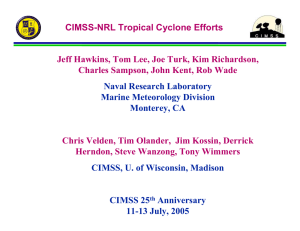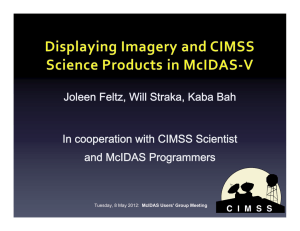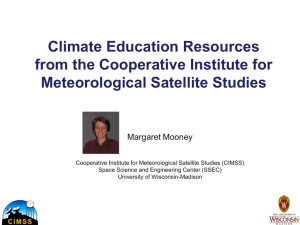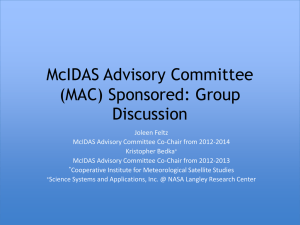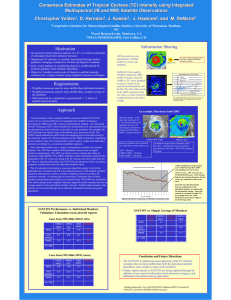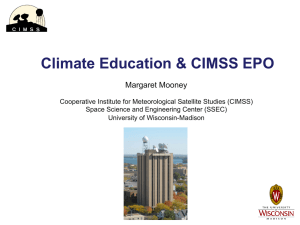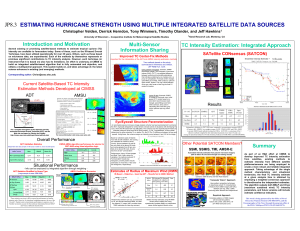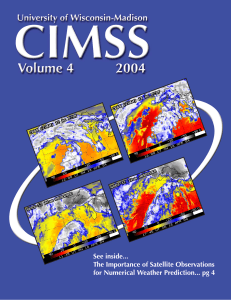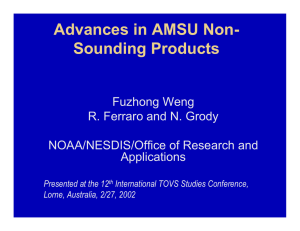TC Analysis & Forecasting Using CIMSS Products Capt Caroline Bower
advertisement
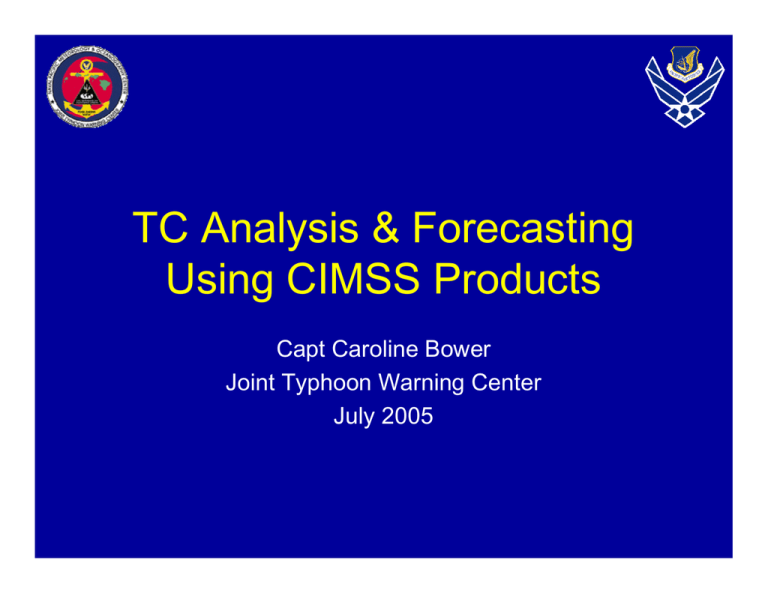
TC Analysis & Forecasting Using CIMSS Products Capt Caroline Bower Joint Typhoon Warning Center July 2005 Overview • JTWC Forecast Process – CIMSS environmental products • • • • AMSU Intensity Estimates Experimental Shear Product Morphing Animations AODT Area of Responsibility - AOR 180o 33% Tokyo 140o CPHC 11% NHC New Delhi 8% 11% La Reunion 17% Australia 13% Nadi, Fiji 7% JTWC Forecast Process 0300Z Watch Turnover 1500Z Watch Turnover 1800Z 0000Z Warning Cycle Warning Cycle 1900-2030Z 0100-0300Z Situational Awareness Warning Cycle Review Old Data & Forecasts AOR Weather Overview Assess Current & Potential Suspect Areas Streamline Analysis Issue Sig. Wx. Bulletin Morning Discussion Review fixes Update BT Send Bogus SAFA Analysis Create Consensus Lay Forecast Track Intensity Assessment Define Wind Radii Create Warning Graphic & Message Issue Warnings Generate & Post 5-Day Aids Customer Notification Calls 0000Z Warning Cycle includes Prognostic Reasoning Bulletin Review AOR Weather • Hemispheric satellite loops – WV, IR, Multispectral – on TeraVision and Mark IVB • FNMOC & NRL TC pages – Microwave & QuikSCAT • CIMSS Real-time Winds & Analyses • Streamline Analysis • Numerical Model Analyses & Forecasts Assess Current & Potential Suspect Areas • Analyze environment surrounding current and potential systems – CIMSS products – Satellite imagery & products – Observations AMSU Intensity Estimates CIMSS/NESDIS-USAF/NRL Experimental AMSU TC Intensity Estimation: Storm position corresponds to AMSU-A FOV 16 [1<--->30] Raw Ch8 (~150 hPa) Tb Anomaly: 0.41 C Raw Ch7 (~250 hPa) Tb Anomaly: 0.53 C AMSU-A MSLP (Ch7): 1000.8 hPa RMW value: 36.6 Km TROPICAL STORM BEATRIZ Thursday 23jun05 Time: 1330 UTC Latitude: 16.81 Longitude: -109.616 Satellite: NOAA-15 ATCF data for Month: 06 Day: 23 Time (UTC): 1200 For imagery, go to http://amsu.ssec.wisc.edu/epac42.html For all comments and questions mailto:chrisv@ssec.wisc.edu JTWC uses microwave to help determine RMW! AMSU Intensity Estimates 25 • Non-homogeneous comparison by storm • Compared to preliminary JTWC best track data • Pronounced negative bias in CIMSS; positive bias in CIRA 20 15 10 5 0 -5 -10 -15 -20 CIMSS CIRA -25 01W 08W 15W 22W 29W AMSU Intensity Estimates 25 • Homogeneous characteristics by storm – Head-to-head comparison of CIMSS & CIRA estimates • Compared to preliminary JTWC best track data • Pronounced negative bias in CIMSS; positive bias in CIRA CIMSS CIRA 20 15 10 5 0 -5 -10 -15 -20 -25 01W 09W 17W 25W STY 09W (Dianmu) Jun 2004 Mean error: -0.2 kt STY 04W (Nida) May 2004 Mean error: -20.3 kt Experimental Shear Product • Provides a 24-hour favorability estimate for intensification based on vertical wind shear every 6 hours • Used by TDOs in conjunction with other tools to assess short term intensification trend Morphing Animations • Operational use limited due to microwave data latency • Used primarily to train new TDOs and analysts on tropical cyclone evolution • Used during post-storm analysis when available AODT • • SeaSpace TeraScan interface currently in use – Time intensive process with cryptic output – Values differ significantly from Subjective Dvorak estimates early in development and during weakening stages – Untested on new (Jun 05) TeraVision upgrade – Uncertain if algorithm will work with MTSAT-1R imagery Web-based program at UW or NRL is ideal – Direct readout desired – Access to archived storm AODT history files for researchers & JTWC – Give analysts ability to manually override center location & scene type Questions? Operational Site: https://metoc.npmoc.navy.mil/jtwc.html Public Reference Site: https://metoc.npmoc.navy.mil/jtwc/pubref/reference.html
